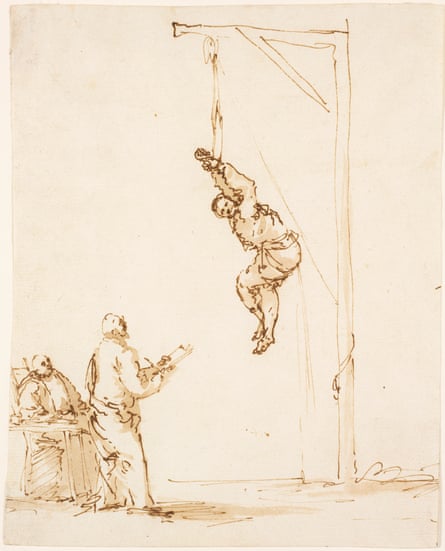What makes the art of 17th-century Europe so universal? This period of religious conflict, revolution, plague and war produced a high proportion of the artists who seem to see most acutely into the human condition. Think of Caravaggio, Rembrandt, Velázquez ... and Jusepe de Ribera.
Dulwich Picture Gallery’s brilliant exposé of this Spanish-born, Italy-based artist’s vision of suffering proves once and for all that he belongs in the same company as the greats. Even Caravaggio never painted anything more insidious than Ribera’s 1637 masterpiece Apollo and Marsyas, the most dazzling of all the horrors lent to this show from great European museums (in this case the Capodimonte in Naples).
A naked man lies splayed on the ground, his head towards us and his face upside down. Blood fills his cheeks and furrowed brow as he opens his mouth in a howl of pain. That mouth is like a cave. Get close and you can see the bumps on his moist tongue. Irresistibly, you twist your body to look at his face the right way up. Suddenly the humanity of those distressed eyes hits you. This is a painting of a torture victim being brutalised before your eyes.
His torturer looks down coldly, calmly cutting off the skin of a suspended leg to reveal a long pink orifice of butchered flesh. This is the god Apollo, punishing the satyr Marsyas for having the hubris to compete with him in musical ability. So much for the ancient story. Ribera makes it savagely matter of fact. What he does keep from the Greek myth is a sound.
Apollo’s viola da braccio – for Ribera replaces the god’s lyre with this Baroque stringed instrument – lies next to the face of Marsyas. This is a pointer to the painting’s invisible power. Marsyas is making a music of his own: the music of pain. The longer you look, the more intensely his scream vibrates. Uncannily this painting seems to make a noise.
Ribera is a painter who can make you feel the physical presence of pain, the proximity of a violated body, the raw nightmare sound of an animal yell, pleading for mercy.
The devastating triumph of this exhibition is that it doesn’t just show Ribera’s achievement. It explains it. Ribera: Art of Violence offers an answer to that poser: what gave artists who lived four centuries ago such insights into human anguish?
Ribera, the show reveals, depicted what he saw. Stripped of its classical trappings, Apollo and Marsyas is a direct observation of the violence that surrounded him. Naples in the 1600s was under Spanish rule, and scrutinised by the Spanish Inquisition. A drawing by Ribera portrays its activities: an Inquisitor sits enthroned, looking up at a man who is hanging in space from a wooden gallows. The torture victim’s hands are tied behind his back and he is suspended from the wrists: as he is questioned, his shoulders are dislocating.

This torture, called the strappado, was just one of the judicial horrors Ribera could see every day just walking around Naples. This exhibition transports you to a time when brutality was openly displayed to the populace. No adult, no child could live in those days without seeing people hanged, beheaded or burned alive. This show documents these quotidian baroque horrors with drawings, prints, court records and a gory painting of mass tortures and executions in the centre of Naples.
The most lurid exhibit is a piece of real human skin with a skeleton tattoo used as a graphic illustration of all the flaying Ribera would have seen, and that he translated into art. Yet the shock of seeing this fades in a moment. The painting next to it will haunt you forever, however. It is hard to look at. A man stares back at you. He is bald and his face is the colour of blood. Then you realise it is not simply the colour of blood, nor is he merely bald. He has been flayed alive. He has no skin. His face is raw flesh, and under it his throat is an exposed network of tendons and tubes. He’s a living anatomical model, carrying his own skin like a coat slung over his arm.
This is the grisliest of Ribera’s many paintings of St Bartholomew, the apostle unfortunate enough to be flayed alive. In another canvas he is being tied down by his persecutors. One of them grins as he looks out of the painting’s shadows. You want to grin back – he seems so refreshingly human, like a joking thug from Game of Thrones. Then a slight glint in the dark reveals the knife in his hand, poised to slice into his victim’s body.
Ribera lived in a world of raw unmediated horror. Instead of prettifying it in his art he exposed its darkest realities. This makes him an artist who will always be contemporary so long as pain, suffering and cruelty exist.
At Dulwich Picture Gallery, London, 26 September to 27 January.

Comments (…)
Sign in or create your Guardian account to join the discussion